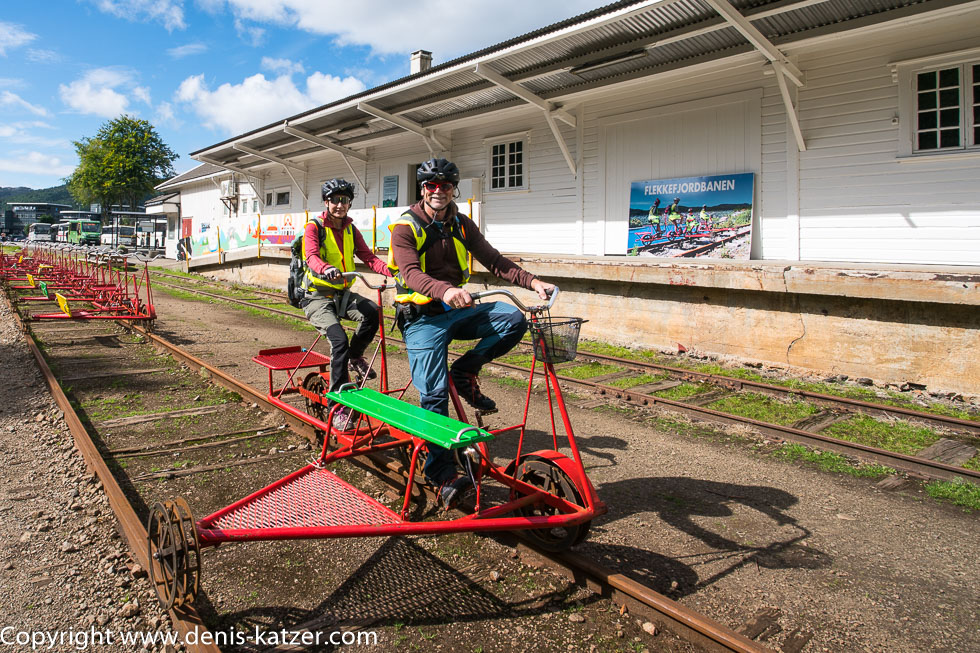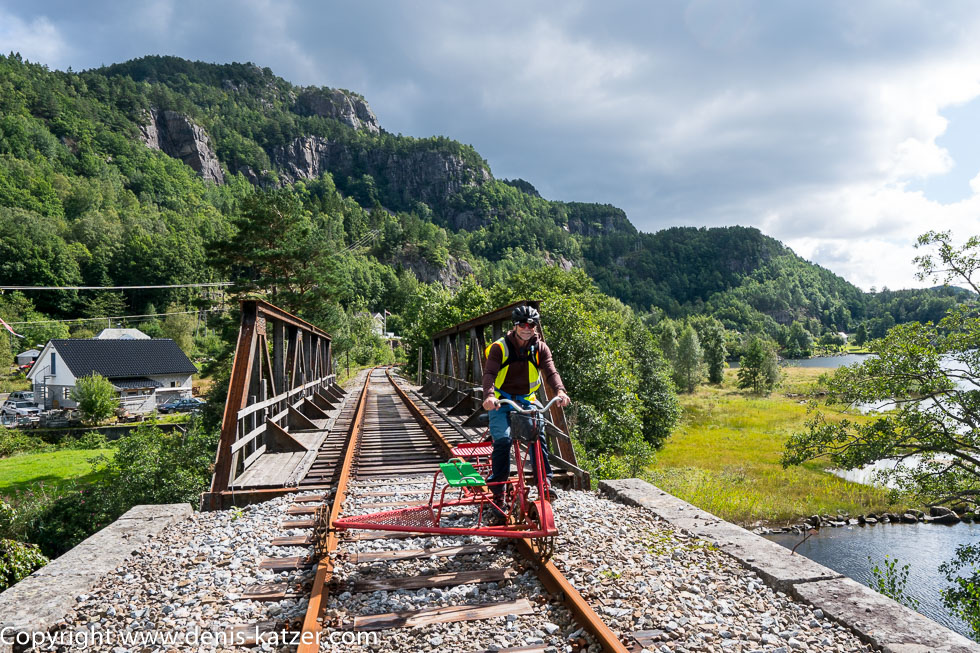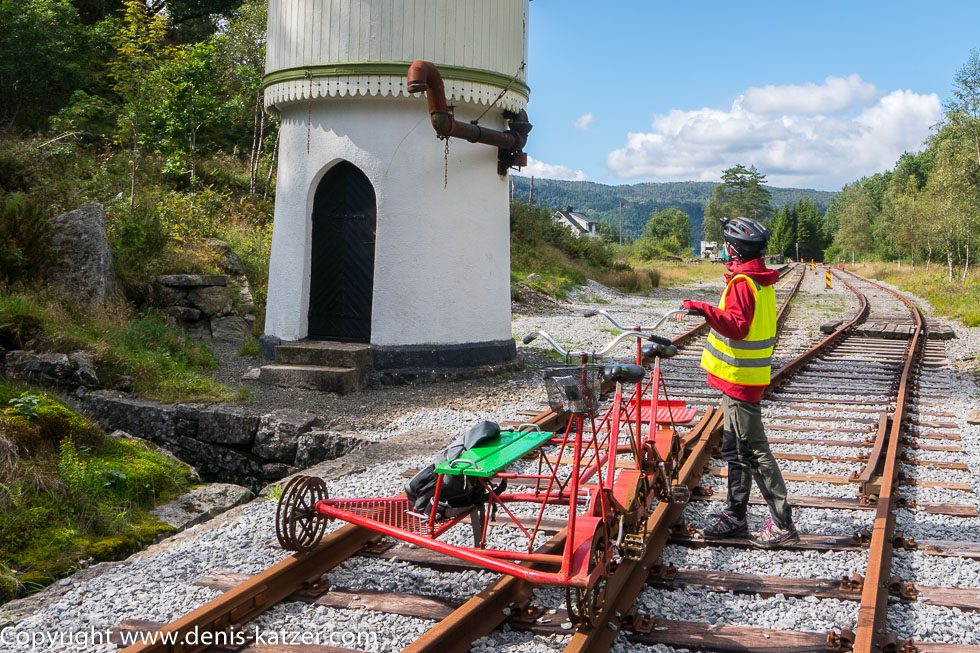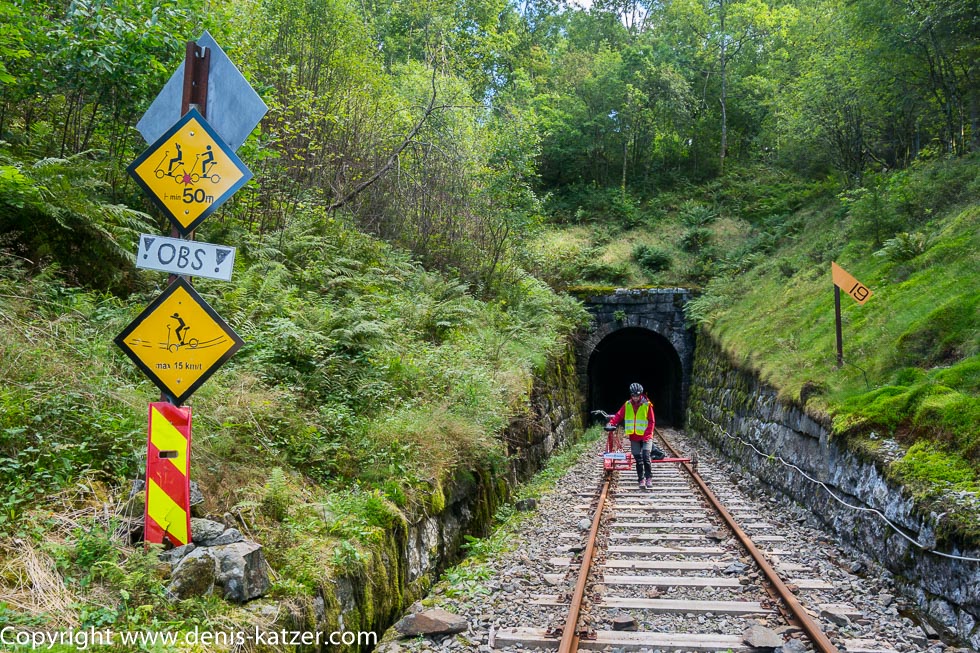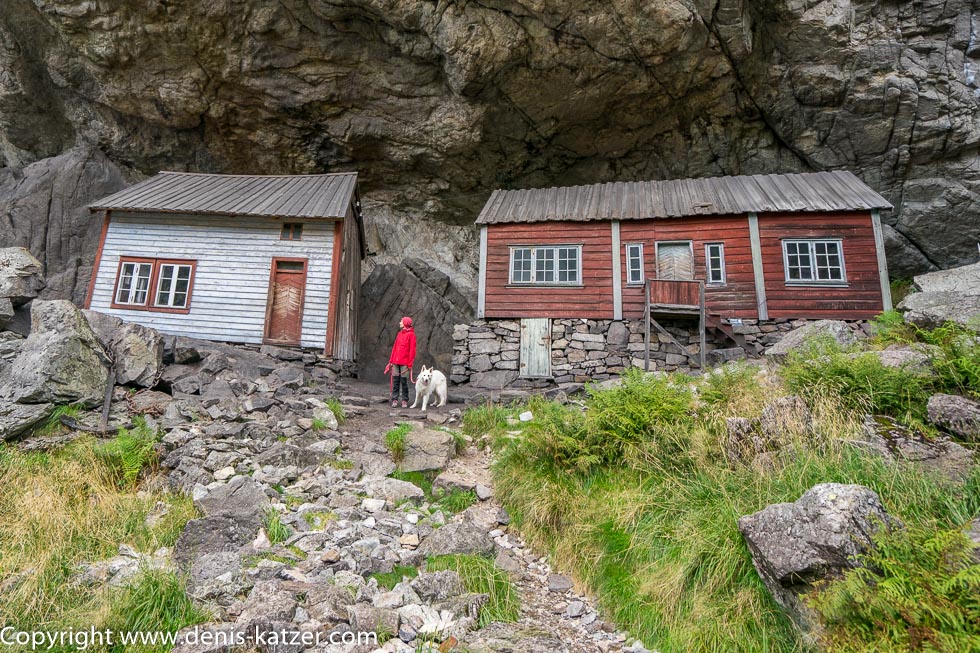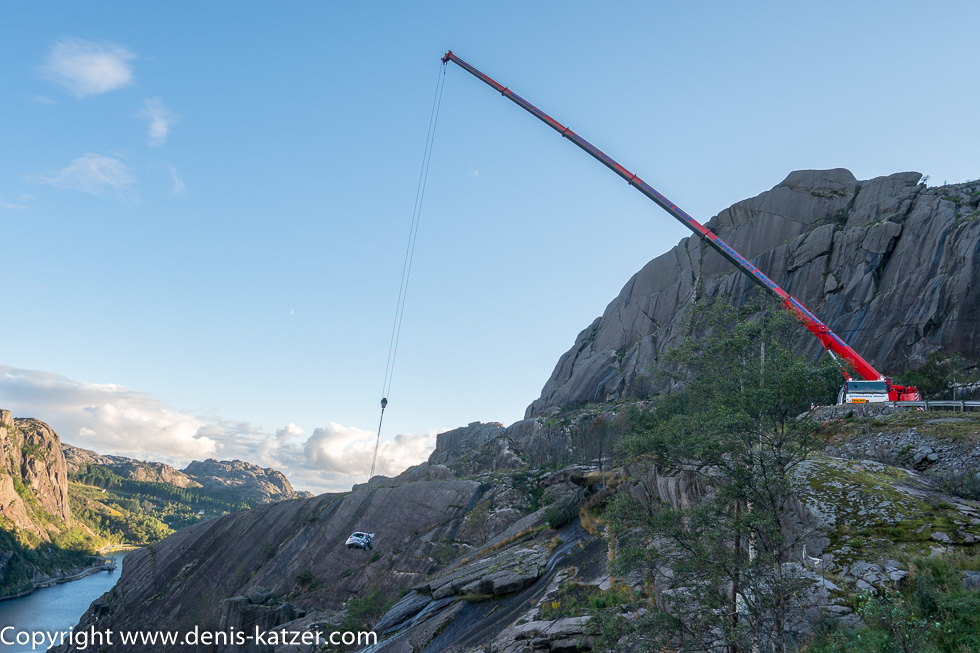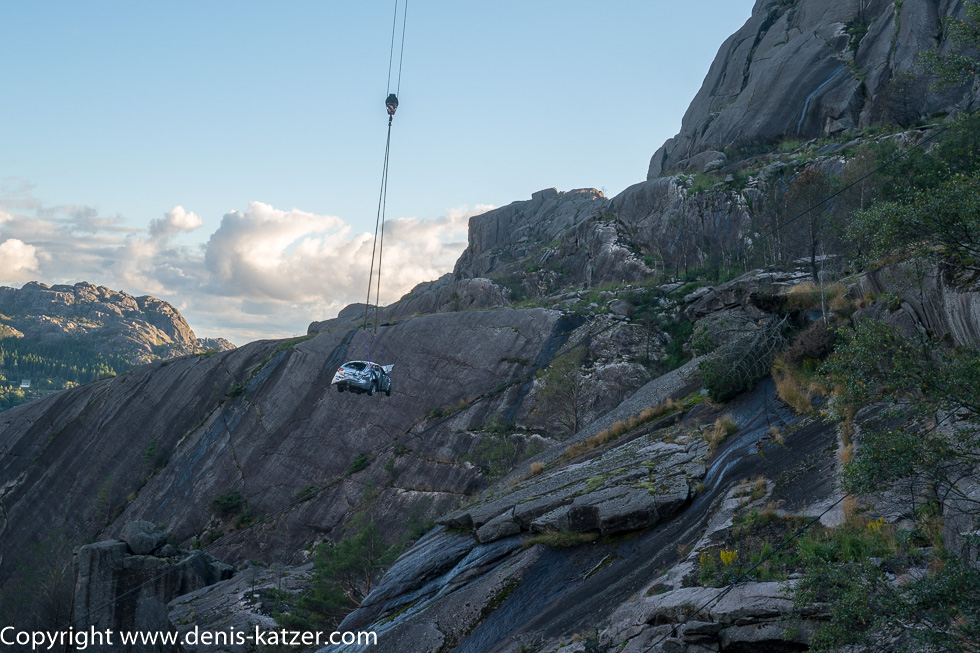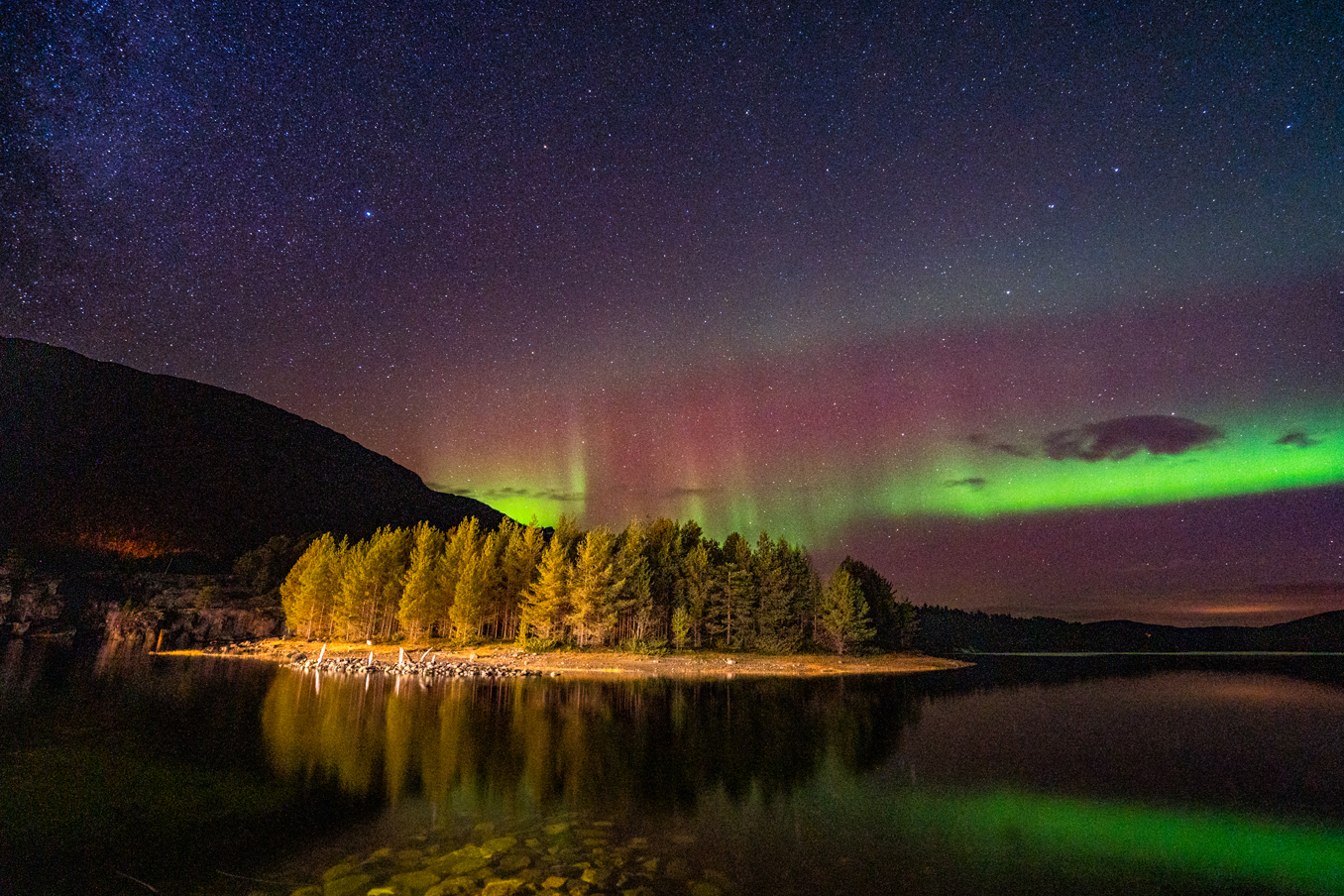
Trolley ride, insights into the past and roadblock
N 58°38.40.7'' E 006°03'07.2''
Date:
24.08.2020
Day: 022
Country:
Norway
Location:
Parking bay by the lake
Daily kilometers:
170 km
Total kilometers:
2443 km
Travel time:
13 hrs
Soil condition:
Asphalt
Bridge crossings:
5
Tunnel passages:
11
Sunrise:
06:14 am
Sunset:
9:02 pm
Temperature day max:
15°
Night temperature min:
13°
Departure:
09:00 a.m.
Arrival time:
22:00
(Photos of the diary entry can be found at the end of the text).
Click here for the podcast!
Link to the current itinerary
(For further contributions click on one of the flags in the map)
A traveler told us about the possibility of riding a bicycle trolley on a disused railroad line not too far from here. “Shall we try it out?” I ask Tanja. “Why not?” “Okay, then let’s drive to the Flekkefjord Railway,” I reply, starting the engine.
We park our Terra at an old train station in the town of Flekkefjord, which is located on the south-west coast of Norway. “It must be there,” I say, pointing to the strange-looking iron racks lined up one behind the other on a track. An advertising brochure tells us that the railroad was one of the most important transport links from 1904 to 1990, connecting the local population to the larger centers in the East and West.
“Can our dog go with us?” I ask a Pakistani who works here. “I don’t know, you’ll have to ask the boss.” The friendly boss, Ephrem Yohannes, comes from Ethiopia. “Can our dog come on the trolley?” I ask him. “As far as we’re concerned, yes. But as a dog owner, you have to decide for yourself. Some dogs enjoy it, others don’t like it.” “I don’t know, looking at the narrow seat, I could imagine Ajaci’s tail getting under the wheels.” “That would be a disaster,” Tanja agrees. “Fine, we’ll leave him in the Terra until then,” I say. We put on our helmets, which are compulsory on the tour and are normally provided by the organizer. As on a normal bike tour, we get ready with a hydration pack, gloves, rain protection, etc. Then we board a trolley, which looks like a tandem with a sidecar. “Let’s go,” I say and start pedaling. Tanja, who is sitting behind me, also has pedals, just like on a tandem bike, and gets the heavy vehicle moving with me. Dong! Dong! Dong! There is a loud clatter over the iron rails as we cross a switch. “It’s a good thing Ajaci isn’t with us. He definitely wouldn’t have liked that,” I say, leaving the bumpy section behind us as we enter a dark tunnel. We switch on our headlamps to be able to see something in the black hole. It drips from the ceiling onto our safety vests, which the organizer has given us. The iron wheels of the trolley rattle over the rails, some of which are covered in lime deposits and make the ride extremely bumpy. The rumble, roar and clatter are reflected back from the rock walls of the tunnel, making our ears ring. “Ah, finally out again,” I say as the tube spits us out again. It passes houses, well-tended gardens, bridges along a beautifully situated lake and deep chasms, some of which are secured with steel barriers. Compared to cycling on the road, the trolley ride is loud, bumpy and uncomfortable, but an interesting experience. As the last tourists started long before us, we don’t expect to meet any other trolley drivers and enjoy being alone when two of the red-painted iron frames appear in front of us. “Well, they’re slow on the road,” I moan to our thing, pedaling up the incline. “Do you want to pass?” asks an elderly lady in the trolley in front of us. “No, don’t let us put you off. We want to take photos from time to time and take our time,” I reply after we see that the drivers in front of us are between 70 and 80 years old and one of them seems to be in a bad way. Half an hour later, we help the holidaymakers from Denmark to lift the heavy trolleys off the tracks and turn them after we have passed so that they can drive back. One of the old men is so disabled that he can’t get off the trolley on his own. His companions are weakened by the exertion, so I help the man, who is probably suffering from the effects of a stroke and can hardly move, off the saddle. Supporting him in my underhand grip, I carry him away from the rails and let him sit on a stone. “Thank you,” says a Danish woman, as the weakened man is unable to speak. “No problem, we were happy to do that. Rest here for a while, then you can drive back with renewed energy,” I reply. “We want to have a picnic here anyway and will stay for at least an hour. Where are you from?” asks the woman. “From Germany.” “Oh, Germany. Thank you again.” “You’re welcome,” says Tanja with a friendly smile. We say goodbye to the holidaymakers and pedal our iron warhorse on, drive through a 1.2 kilometer long, dark, noisy tunnel and as we come out on the other side, thunderclouds are gathering. “I don’t know if it makes sense to continue. I don’t find the tour particularly relaxing,” says Tanja. “Would you like to turn back?” “If you don’t mind, yes.” “Hm, okay. I think we’ll soon have reached the end of the 17-kilometre route anyway,” I reply, whereupon we join forces to lift our trolley, turn it 180 degrees and put it back on the tracks. On the way back, we pass the pensioners again. “Is everything okay with you?” asks Tanja. “Yes, yes, everything’s okay. We’ll be heading back soon,” replies the Danish woman. Although we were the last to set off, we are the first to reach the trolley station because we turned back early. “But they’re back quickly,” marvels Ephrem Yohannes. “We were filming behind the long tunnel,” I reply. “Well, it wasn’t far to the end of the route. You must be really fit?” “OK, but we’re no strangers to cycling. We rode our bikes from Germany to Thailand,” I explain. “Wow, that’s a long way,” he replies, whereupon we get into a lengthy conversation. “And you like it in Norway?” I ask during our chat. “Yes, very good. I’ve lived here for nine years, I speak Norwegian and it’s one of the most beautiful countries in the world. “And you don’t mind the cold and all the rain?” I wonder. “I got used to it then. The Norwegians are a nice people. However, they live a very secluded life. Here in Ethiopia, people are more open. It’s easier to make friends in Africa. Not here. I have to get involved in society and am in several clubs to make friends and be accepted. With my black skin color, that’s also not easy. However, there is a lot of misery and poverty in my country, whereas here people are better off. Everything is expensive, but you also earn a lot more money. All in all, I feel comfortable and at home here,” chats Ephrem Yohannes. Before I say goodbye to him, he gives me a Flekkefjord Railways T-shirt. “Thank you,” I say, putting the shirt on straight away. “Take one for your lovely wife too. What size is she?” he asks, laughing as he hands me another shirt for Tanja. “Good luck and good health on your travels,” he wishes me as I leave the building. “Have a good life in this beautiful country too,” I say as I say my final goodbyes.
With the old wooden houses of Helleren, we reach another extraordinary place in the late afternoon. The huts are tucked under a 60-meter-high rock overhang, which even then protected people from the extreme weather. “It’s amazing how simply and remotely people lived,” I say, wandering around the well-preserved wooden huts. “Surely there wasn’t a road back then that led us into the valley like there is today?” Tanja suspects. “The road and the tunnel into the valley were only completed in 1921,” I read on an information brochure. “Until then, the houses under the rock, where up to three families lived, were a kind of hermitage. You could only reach the settlers, who lived mainly from fishing and kept a few sheep as livestock, via the Jøssingfjord, i.e. by boat, or you had to hike over the mountains.” “Imagine if one of the inhabitants had a toothache or some other problem,” Tanja ponders. “I can’t imagine,” I reply, climbing the small wooden staircase to the hut. “When did the settlers move away from here?” asks Tanja. “If the information is correct, they lived under the rocks until 1920. However, they were not the first to use the overhang. Archaeologists found traces from the Palaeolithic period under the rock overhang.” “That would mean that people lived here a million years ago,” Tanja concludes, looking out over the fjord and the valley. “That’s right, back then they had to protect themselves from bears, wolves and I don’t know what other large animals. A huge rock overhang like this offered protection,” I ponder on the way back to our car.
Wooouuuuuiii! Wooouuuuuiii! Ajaci shouts as we drive off. “Should we put him in the dog crate in the back of the car?” Tanja ponders. “I don’t know. Maybe that’s a good idea. However, I still hope he recovers from the fire extinguisher scare,” I reply, winding up the narrow hairpin bends. Suddenly a police car blocks our onward journey. “You’ll have to wait here for an hour or two. There’s been an accident and the recovery team is trying to lift the crashed car out of the depths,” a young policewoman informs us. We park the Terra in a small rest area that appears purely by chance at the bend. “I’ll see what’s going on,” I say, grab the camera and leave our mobile. Several truck drivers stand at the edge of a cliff, gazing into the depths. “Wow, he’s fallen a long way down,” I realize, shocked, discovering the completely dented car on a rocky outcrop. “Yes, he’s been badly hit,” says one of the drivers. “Did he survive?” I wonder. “No, nobody survives that. According to the people in the valley, it was suicide,” says the man wearing overalls. “Suicide?” I ask. “Yes, that’s suspected. They took the man out yesterday with a helicopter. The crane truck is from Bergen,” he replies curtly. A huge mobile crane stands above us, its long boom stretched out into the cloudy sky. At its end is a steel cage in which the crane operator lowers two rescue specialists. When they arrive at the bottom, they climb out of the basket and carefully work their way the last 20 or 30 meters to the damaged vehicle. It takes a while for them to attach the recovery straps to the car properly. Half an hour later, they give the okay sign. The wreck slowly rises into the air. “Looks spectacular,” I say to the man next to me, who replies with a brief nod. After the crew have lashed the broken-down car to a tow truck, the police clear the roadblock. “Have a safe journey,” the police officers wish us. “Thank you, you too,” I reply.
Long shadows are cast over the mountains around us. The sun hid a long time ago and the darkness takes over the country. We follow the navigation system, turn down the pass again, drive through a few villages. Suddenly the road narrows and a construction worker in reflective clothing stops us. “We are currently repairing the road. Please wait here until you are picked up by a service vehicle,” he says in a friendly manner. A few minutes later, we are following a car at walking pace. We want to spend the night at Eigerøy fyr, another lighthouse on the southwest coast of Norway. “According to the satnav, we should turn right here,” says Tanja. The service vehicle continues straight ahead. He doesn’t know that we want to go to the lighthouse,” I say. “What should we do?” asks Tanja. “We’ll turn right,” I decide. As soon as we turn off, a sign stops us. “Closed to vehicles over 3.5 tons.” “Okay, we’ll turn back,” I decide again. Because the narrow road simply ends at the coast, we turn back. Once again we are picked up by the service vehicle. This time in the other direction. We decide not to visit the lighthouse and drive on to find a suitable spot for the night. “It’s funny, sometimes there’s one parking bay after another and now, when we need a space, there’s nothing,” I fret as it’s already 9:30 pm and tiredness is creeping into our bones after the exhausting day. 10 minutes later we discover a narrow gap in a truck parking lot. “It’s too risky for me. Imagine if he misjudges by just one centimeter when driving away with his truck, he’ll turn us into mush. Not a good idea,” I think tiredly. A few hundred meters down the road, we discover a shopping center with a deserted, empty parking lot. “The place doesn’t feel good somehow. It has an eerie energy,” Tanja feels, whereupon we drive on again. The clock hand moves forward to the number 22 as I head for a parking bay by a lake in heavy rain. We are the only ones with a 38-tonner. “We’ll stay here,” I decide repeatedly and turn the ignition key, now dead tired. “Phew, what a day,” says Tanja, leaving the driver’s cab. I type the coordinates into the GPS for my logbook, write down the mileage and follow Tanja…
